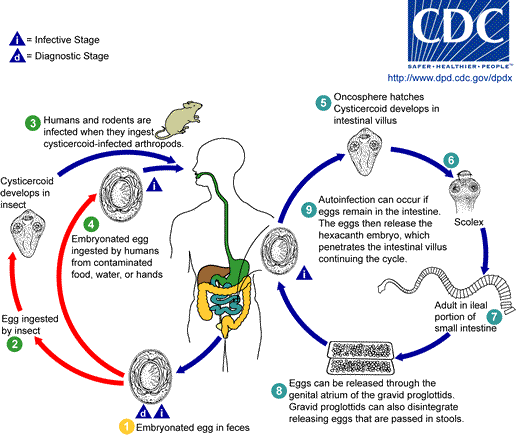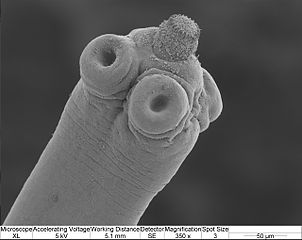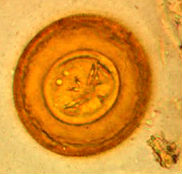Hymenolepis nana life cycle
Online Biology Dictionary
|
|

 Scolex (head) of a Hymenolepis tapeworm. Image: Magdalena ZZ
Scolex (head) of a Hymenolepis tapeworm. Image: Magdalena ZZ Hymenolepis oncosphere, or egg. These oncospheres are slightly oval (70-86 µm by 60-80 µm), with a striated outer membrane and a thin inner membrane. The space between the membranes is smooth or faintly granular. Each oncosphere has six hooks; for this reason they are also called "hexacanth larvae" (six-hooked larvae).
Hymenolepis oncosphere, or egg. These oncospheres are slightly oval (70-86 µm by 60-80 µm), with a striated outer membrane and a thin inner membrane. The space between the membranes is smooth or faintly granular. Each oncosphere has six hooks; for this reason they are also called "hexacanth larvae" (six-hooked larvae).
Eggs of the tapeworm Hymenolepis nana are infective when passed with the stool, but cannot survive more than about 10 days outside the body.
When eggs are ingested by an arthropod intermediate host (a variety of fleas and beetles can serve as intermediate hosts), they develop into cysticercoids, which can infect humans or rodents upon ingestion and develop into adults in the small intestine.
A morphologically identical variant, H. nana var. fraterna, infects rodents and uses arthropods as intermediate hosts.
When eggs are ingested (in contaminated food or water or from hands contaminated with feces), the oncospheres contained in the eggs are released. The oncospheres (also known as "hexacanth larvae") -- see picture at right -- penetrate the intestinal villi and develop into cysticercoid (encysted) larvae. Upon rupture of the villus, the cysticercoids return to the intestinal lumen, evaginate their scolices, attach to the intestinal mucosa and develop into adults that reside in the ileal part of the small intestine and produce gravid proglottids. Eggs, when released in the small intestine, are passed in the stool.
An alternate mode of infection occurs, known as internal autoinfection, where the eggs release their oncospheres, which then penetrate the villi continuing the infective cycle without leaving the host's body. The life span of adult worms is four to six weeks, but internal autoinfection can permit an infection to last for years.
Other diseases carried by mice >>
Video: Hymenolepis nana
Most shared on Macroevolution.net:
Human Origins: Are we hybrids?
On the Origins of New Forms of Life
Mammalian Hybrids
Cat-rabbit Hybrids: Fact or fiction?
Famous Biologists
Dog-cow Hybrids
Georges Cuvier: A Biography
Prothero: A Rebuttal
Branches of Biology
Dog-fox Hybrids